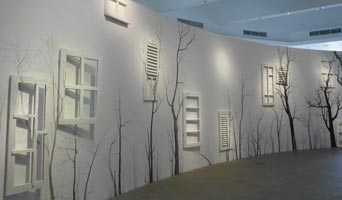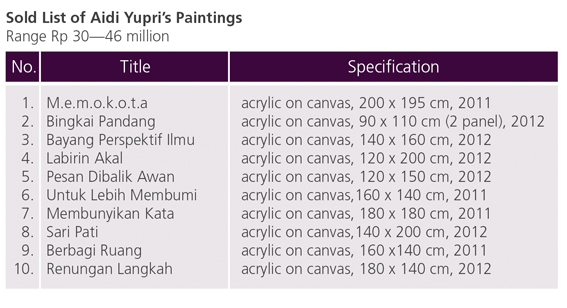Communicating personal concepts to the public will always be a source of struggle for an artist, especially in choosing what idiom will be used. This is why the success of a work may be measured by whether or not an audience is able to bring out a certain meaning, by appreciating its idiom. In terms of conceptual delivery, Aidi Yupri’s paintings, exhibited in his solo show “Semester Terkembang Jadi Buku” at Art:1 Gallery from 12-26 January 2013, was considerably successful.
For this exhibition, the artist, an alumnus from Indonesia Art Institute (ISI) Yogyakarta, had chosen to work with idioms that are universal. Corresponding to the exhibition’s title, curated by Suwarno Wisetrotomo, Aidi chose idioms that are related with nature, which stands linearly to his expressive language of contemporary naturalism. He combines trees, wood, forests, clouds, mountains, and cityscapes such as rows of buildings. He arranges these objects, and presented them to the public as if they were parts of the pages of a book. Here, Aidi clearly shows his desire to have his work seen as a reading process, which he hopes will be have subversive impact on the public.
This aim was not fully achieved. In terms of comprehensibility, his works are successful. But to arrive at a process that subverts or perturbs, there still seems to be a long way to go. A saccharine sense of safety surrounds Aidi’s poeticization of his object-idioms. If we create an allusion to poetry, Aidi’s painting is lyrical without creating any tension or discomfort.
A number of lyrical images may be seen in the work Batang Penyangga (acrylic on canvas, 99 x 110 cm). Five palms face upwards, where each finger shapes the form of tree-branches. A purple sky stands as a backdrop. It is incredibly romantic. The poetic nuance is strengthened by the presence of alphabets, shadowing every palm of a hand and the branches of the trees.
A large part of the works by the artist, born in Magelang, 24 December 1981, takes up trees and its elements. The tree-idiom is an easy choice when an artist wishes to express themes about nature. Outside of trees, Aidi chose the object of buildings, which provided a contrasting atmosphere to the lyrical emptiness that trees create. This is visible in the work M.e.m.o.k.o.t.a. (acrylic on canvas, 200 x 195 cm). From afar, the line of building looks as if they were on the verge of collapsing at the base; on closer view, the dust falling off them turns out to be groups of alphabets.
Aidi’s choice of trees as his objects is romantic. His close relationship to trees and nature began in childhood with his grandfather and father, who often planted teakwood in his hometown, Pancuran Mas, Magelang. Through the memory, Aidi considers trees to be an object of self-reflection. “These works, a kind of notes for me, what I observe in nature, what I get from nature, as a media of study in living life,” Aidi mentions.
In Suwarno’s eyes as a curator, Aidi reflects his experiences in a tree’s way of life. “I think this reflective question is very interesting and drove me to frame the exhibition as the universe expanding into a book,” Suwarno explains, referring to a book by A. A. Navis titled Alam Terkembang Jadi Guru.
Suwarno tells us further that the idiom of books that Aidi presented in his works are objects that contain connotative understanding that point the necessity of reading. “Reading as in reading a book, but also reading the whole universe,” he adds.
Exhibiting 16 paintings and 2 installations, Aidi considers the works in the solo show to be more focused than his previous exhibition, “Alam Menggugat” (2010). Then, there was only one painting that takes the form of a book, in two-dimensions.
In his curatorial essay for the “Alam Menggugat” exhibition, Wayan Kun Adnyana explains a similar idea to Suwarno’s. He describes how at the exhibition, Aidi assigns to nature the role of a life guru. How Aidi consciously desires to hear the laments, crying whimpers, wise words, as well as all of nature’s protests about people’s way of life. How he regards nature as the most perfect holy book. Aidi turns the book into a visual sign. The book, whether in denotative and connotative terms, is necessarily an inexhaustible site of knowledge.
This meaning was emphasized by Suwarno in his essay for “Alam Terkembang Jadi Buku”. Trees are cut down and turned into paper; the book is understood denotatively. In its connotative understanding, the book reminds us to read the universe as God’s verses. As in a book that was squeezed, and from it emerges letters transforming into leaves in Sari Pati (2012). The book as a source of knowledge reminds one of our beginnings.
As a thematic solo exhibition, the consistent manner of Aidi’s works is also apparent in his installation works. For instance, in the work Celah Tanpa Batas (20120); inside are tiny windows, where visitors are able to peek through the branches of a tree that gradually become smaller. “We can put windows inside our mind, we can see what goes on in there and dig into spiritual thoughts, an awareness of God,” Aidi mentions.
Several of the visitors who came to the opening were satisfied and impressed by Aidi’s two-dimensional work, one of the being Asikin Hasan. “Aidi shows that painting will never die, as it always has ways to re-invent itself, no one ever imagined that a painter could do this, suddenly his painting is like a book, whereas it is usually on canvas and is flat. We are entering something new and we can say that this is two-dimensional. Because of this, this is a new contribution to painting. I see this as a promising development to painting in the present day,” says Asikin, who is also a curator to many art exhibitions.
From the market perspective, responses from art enthusiasts to Aidi’s works are relatively appreciative. This is proven in how the artist, who was a finalist at the Bandung Contemporary Art Awards #1, was able to auction his work titled Belantara Teks 2010) to Rp 60 million, an increase from other paintings in the collection that range around Rp30 – Rp46 million. By further exploring discourse, Aidi Jupri may certainly create more critical works that could move the soul of his audience.
Celah Tanpa Batas, wood, installation,
variable dimension (10 windows panel), 2012
Sari Pati, acrylic on canvas, 140 x 200 cm, 2012








